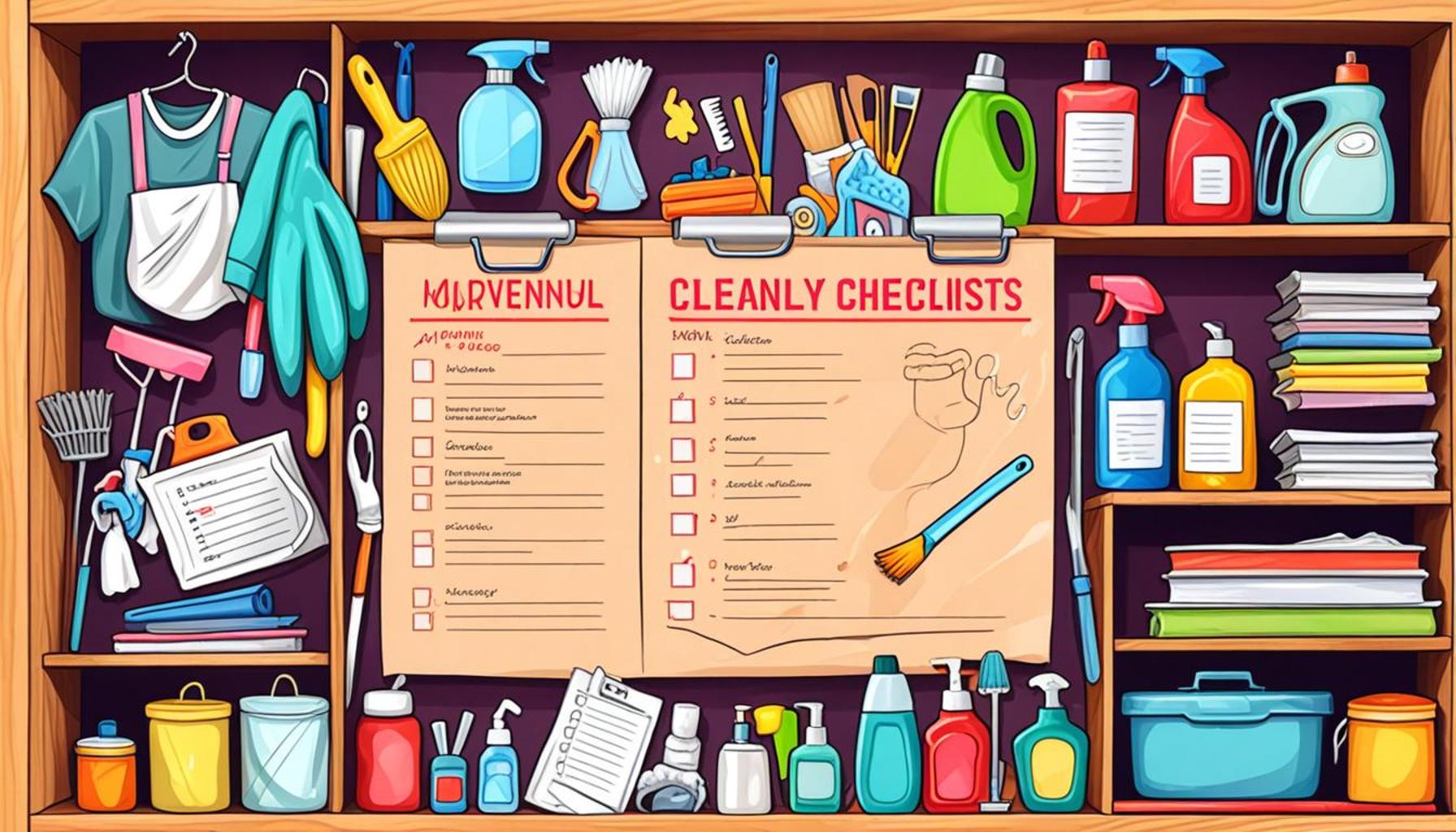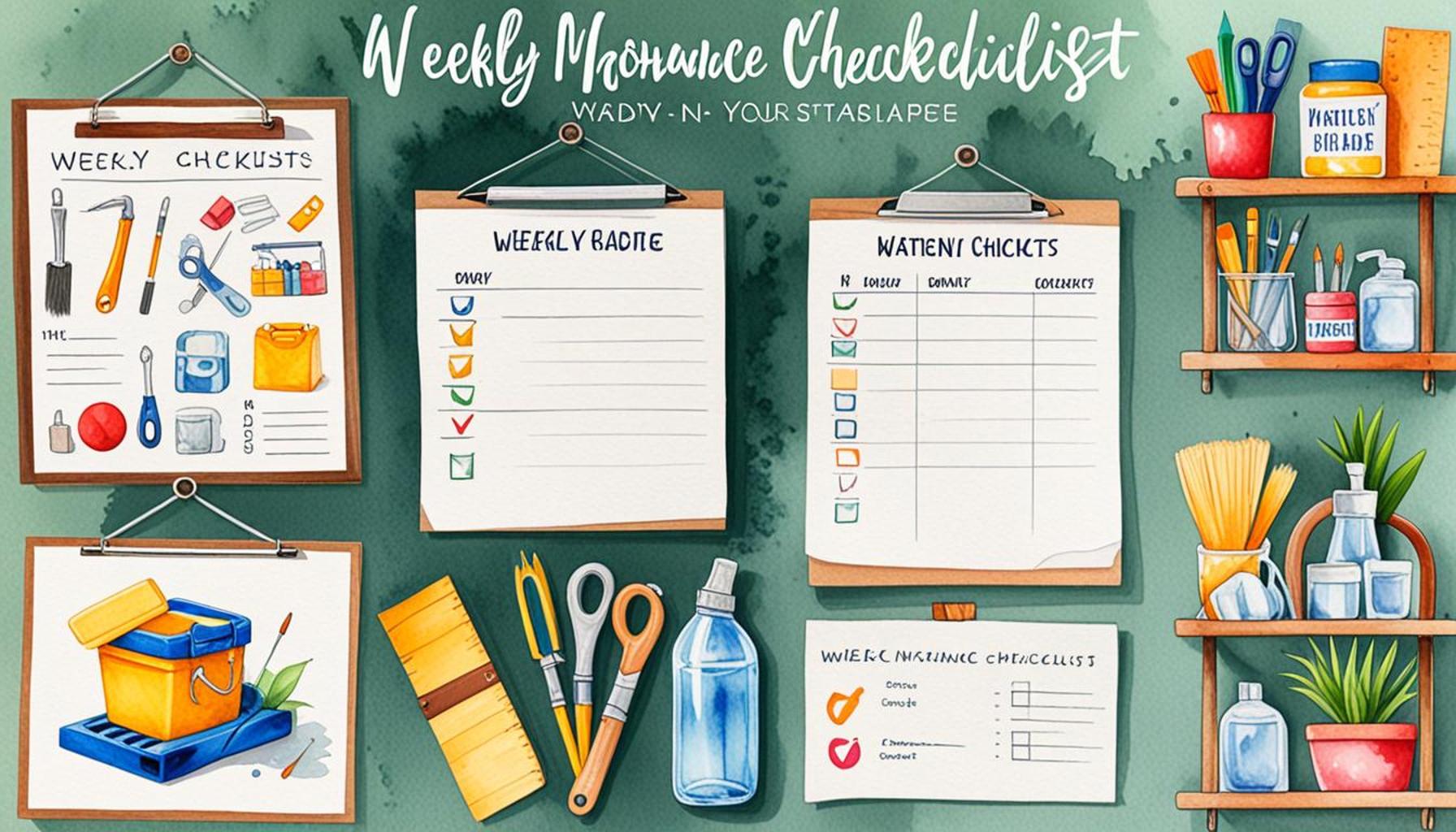Essential Checklists for Eco-Friendly House Cleaning

Introduction
With increasing awareness about environmental issues, eco-friendly house cleaning has become a priority for many households. This shift is not just about reducing toxic chemicals; it’s about embracing sustainable practices that contribute to a healthier planet. Traditional cleaning products often contain harmful substances that can linger in the air and water supply, leading many consumers to seek alternatives that are not only safer for their families but also for the environment.
By utilizing essential checklists, you can streamline your cleaning routine while making eco-conscious choices. Below are some critical components to consider when transitioning to more sustainable cleaning methods:
- Natural Cleaning Products: Replace harsh chemicals with simple, effective alternatives such as vinegar, which acts as a natural disinfectant, and baking soda, known for its ability to neutralize odors and scrub surfaces. Essential oils like tea tree and lavender not only provide pleasant scents but also offer antibacterial properties. For instance, a mixture of vinegar and water can effectively clean windows and mirrors, leaving them streak-free without the chemical residues found in commercial products.
- Recycling Tips: Implementing a system for recycling paper, plastics, and glass in your home doesn’t require significant changes but can greatly impact waste reduction. Consider starting with a recycling station in your kitchen, where you can easily sort recyclables from regular trash. Familiarizing yourself with local recycling guidelines can enhance your efforts and ensure materials are properly processed. Many communities offer curbside recycling or drop-off centers for larger items.
- Energy-Efficient Appliances: The use of energy-efficient tools, such as vacuum cleaners, washers, and dryers, can minimize electricity usage during cleaning. Look for appliances that hold the Energy Star label, which indicates they meet energy efficiency guidelines. For example, using an energy-efficient washer can save you up to 30% in energy consumption compared to standard models.
The benefits of implementing these tips go beyond just a cleaner home. By adopting eco-friendly practices:
- You contribute to less environmental pollution. Reducing the number of harmful chemicals introduced into the ecosystem can help preserve local water sources and wildlife habitats.
- Your indoor air quality can improve. Natural cleaning products emit fewer volatile organic compounds (VOCs), leading to healthier air and reducing allergy symptoms among sensitive individuals.
- You may save money in the long run. By opting for cheaper, natural cleaning ingredients and energy-efficient appliances, you can significantly cut down on household expenses over time.
As you explore the following sections, you’ll uncover essential checklists that will revolutionize your cleaning routine. Prepare to embark on a journey toward a more sustainable and eco-friendly home, learning more about how your actions can make a difference not just inside your house but across the planet as well. Embracing these practices not only enhances the well-being of your family but also fosters a caring attitude toward the environment that future generations will benefit from.
DISCOVER: Click here for time-saving cleaning tips!
Natural Cleaning Products: The Heart of Eco-Friendly Cleaning
When it comes to eco-friendly house cleaning, the adoption of natural cleaning products is an essential starting point. These alternatives not only safeguard the environment but also ensure the safety of your family. Traditional cleaners often harbor a cocktail of synthetic chemicals that can trigger allergies, respiratory issues, and contribute to a host of other health problems. The shift toward natural products allows you to mitigate these risks while maintaining an effective cleaning regimen.
Household staples like vinegar, baking soda, and essential oils can serve as powerful cleaning agents. For instance, vinegar’s natural acidity can tackle tough stains and deodorize surfaces without the use of harsh chemicals. A simple solution of equal parts vinegar and water works wonders for cleaning kitchen counters, while a sprinkle of baking soda can transform your bathroom fixtures into a shining oasis. Moreover, incorporating essential oils such as lemon or eucalyptus not only fragrances your home but also provides antimicrobial benefits.
Creating a Recycling Routine: Your Contribution to a Greener Planet
A pivotal aspect of eco-friendly cleaning lies beyond just what you clean with; it relates significantly to what you do with waste. Developing a systematic recycling routine can significantly minimize your household’s carbon footprint.
- Establish a Recycling Center: Designate a specific area in your home where family members can easily sort recyclables. Using bins labeled for paper, plastics, and metals will facilitate this process and help everyone stay organized.
- Know Your Local Guidelines: Familiarize yourself with local recycling rules to ensure that you’re compliant. Different regions have varying practices for recyclable materials. For example, some areas may not accept certain types of plastics or glass.
- Reduce Contamination: Rinse out food containers before placing them in the recycling bin. Contaminants can spoil entire loads of recyclable material, rendering them non-recyclable.
By making these small adjustments, you play a significant role in reducing landfill waste and conserving natural resources.
Introducing Energy Efficiency into Your Cleaning Routine
Another crucial component of eco-friendly house cleaning is the use of energy-efficient appliances. Investing in appliances that meet Energy Star standards is a long-term strategy that pays off. These appliances use advanced technology to consume less energy, resulting in lower utility bills and reduced greenhouse gas emissions.
- Vacuum Cleaners: Opt for cordless or bagless vacuum cleaners that are designed for energy efficiency. Certain models use less power without compromising on suction strength.
- Washing Machines: Modern Energy Star certified washing machines consume less water and electricity compared to older models. They also often feature quick cycles that get the job done while saving energy.
- Dryers: Energy-efficient dryers not only dry your clothes efficiently but may also have moisture sensors to prevent over-drying, thereby saving energy.
Integrating these eco-friendly appliances into your cleaning routine can significantly reduce your household’s energy usage, making a positive impact that resonates well beyond your living space. As you continue down this path, you’ll discover that these choices not only lead to a more sustainable home but also set an example for others. Embrace these essential checklists as the foundation for a healthier, greener lifestyle.
Essential Checklists for Eco-Friendly House Cleaning
Maintaining a clean home doesn’t have to come at the expense of the environment. With the right checklists, you can streamline your eco-friendly house cleaning routine. Below is a table showcasing the significant advantages of utilizing checklists in your green cleaning practices, ensuring you cover all essential steps while being mindful of our planet.
| Category 1 | Category 2 |
|---|---|
| Efficiency | Checklists help you allocate your time wisely, ensuring every area of your home is addressed without wasting resources. |
| Sustainable Practices | Adhering to eco-friendly products and methods can easily be tracked by using checklists, promoting a cleaner environment. |
These checklists not only enhance your cleaning efficiency but also reinforce your commitment to sustainability. By opting for eco-friendly house cleaning practices, you’re contributing to a healthier planet while creating a safe home for your family. Let’s dive deeper into how you can create effective checklists tailored to your cleaning needs!
DISCOVER MORE: Click here to learn how to choose the best cleaning products
Embracing Sustainable Practices: The Power of Reusable Items
In the journey toward a greener home, incorporating reusable cleaning items is paramount. Not only do they reduce waste, but they also offer a more sustainable approach to your cleaning routine. Transitioning away from single-use products can have a substantial impact on your household’s ecological footprint.
- Microfiber Cloths: These versatile cloths are perfect for dusting, wiping surfaces, and even cleaning windows. They effectively capture dirt and grime without the need for chemical cleaners, making them both an eco-friendly and cost-effective choice. Unlike paper towels, which contribute to deforestation and can only be used once, microfiber cloths can be washed and reused hundreds of times.
- Reusable Mop Pads: Traditional mop pads are often disposable, adding to landfill waste. By using mops that feature washable pads, you can clean your floors without contributing to the plastic problem. There are a variety of mop options available, including steam mops, which not only save on cleaning supplies but also reduce the need for harsh chemicals.
- Beeswax Wraps: While not a traditional cleaning item, beeswax wraps can be a sustainable substitute for plastic wrap when covering food items or food prep surfaces. This change helps you eliminate plastic waste while keeping your kitchen clean and organized.
Moving towards reusable items contributes significantly to waste reduction and is a wonderful way to adopt more sustainable habits within your household.
The Importance of Indoor Air Quality: Natural Solutions
Indoor air quality often gets overlooked in discussions about eco-friendly house cleaning, yet it plays an essential role in our overall health. Conventional cleaning products can emit volatile organic compounds (VOCs), which contribute to indoor air pollution. Showing a preference toward natural solutions not only cleans your home but also promotes a healthier environment.
- DIY Air Fresheners: Instead of relying on store-bought air fresheners that often contain harmful chemicals, consider making your own. A simple mixture of water and essential oils can effectively neutralize odors while providing a natural fragrance. Try using essential oils like lavender or tea tree, which also have antibacterial properties.
- Houseplants: Certain houseplants, such as spider plants, snake plants, and peace lilies, act as natural air purifiers. They absorb toxins while releasing oxygen, thus improving indoor air quality. Incorporating a variety of plants around your home is a visually pleasing and effective way to keep the air fresh.
- Odor Neutralizing Solutions: Common household items like baking soda can work wonders for eliminating stubborn odors. Sprinkle baking soda on carpets or in your fridge, let it sit, and then vacuum or wipe away to reveal a cleaner, fresher scent.
Improving indoor air quality with these natural strategies not only promotes a healthier living environment but also complements your overall eco-friendly cleaning efforts.
Prioritizing Water Conservation: Smart Cleaning Techniques
In the realm of eco-friendly cleaning, water conservation is a crucial consideration. With rising concerns over water scarcity in some regions of the United States, adopting water-saving methods can enhance your sustainable cleaning practices.
- Efficient Dishwashing: Rather than running a constant stream of water, consider filling your sink to wash dishes or opt for a modern dishwasher that uses less water than the traditional hand-washing method. Also, wait until you have a full load to run your dishwasher, maximizing water usage.
- Cleaning Solutions in a Bucket: When mopping your floors, use a bucket instead of continuously running water from the tap. This will significantly reduce water waste and still provide an effective cleaning solution.
- Shorter Showers for Cleaning Projects: If you’re engaged in cleaning tasks that require water, like rinsing down outdoor surfaces, consider timing how long you run the water. Shortening these activities can lead to substantial water conservation over time.
Integrating these water conservation practices into your cleaning routine reinforces a commitment to eco-friendly values and contributes toward a sustainable future.
DISCOVER MORE: Click here for essential checklists
Conclusion: Championing a Greener Cleaning Routine
In an era where environmental consciousness is paramount, adopting eco-friendly house cleaning practices is not only a responsible choice but also an enriching lifestyle change. By employing reusable cleaning items, you significantly minimize waste and reduce your household’s carbon footprint. The switch to products like microfiber cloths and washable mop pads marks a step toward a more sustainable home environment. Furthermore, enhancing your indoor air quality through natural solutions helps foster a healthier living space, free from harmful chemicals and toxins.
Equally critical is the commitment to water conservation in your cleaning routine. By embracing methods that save water, such as efficient dishwashing and bucket-based mopping, we collectively contribute to alleviating the pressing water scarcity challenges faced in various regions. Each small change adds up, highlighting the power of individual actions in the broader context of environmental preservation.
In conclusion, by utilizing our essential checklists for eco-friendly house cleaning, you not only cultivate a cleaner home but also embrace a sustainable lifestyle. As you implement these practices, consider sharing your journey with friends and family to inspire a collective movement toward eco-conscious living. Explore deeper into the wealth of resources available, from DIY cleaning solutions to innovative green products, to further enrich your eco-friendly cleaning endeavors. Together, we can cultivate cleaner, greener homes for generations to come.


